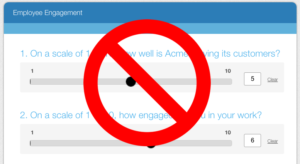Jan 10, 2017
Combat Employee Survey Fatigue
Our clients increasingly ask us to help them combat survey fatigue. In the worst case, an employee sees an annual survey, monthly or weekly pulses, and a happy/sad face each time they leave the building. Plus they see a ballooning number of surveys in their personal lives. It’s no wonder that surveys, like ads themselves, are being ignored. But real employee feedback is critical. Here are some Vision Lab recommendations for combating survey fatigue.
#1 Shorten Surveys
OK, this one is obvious, but what isn’t obvious is exactly how short a survey should be. At The Vision Lab we ask pairwise questions–an employee is repeatedly given two answers to a question and they pick the better answer. Employees can do this as often as they want. How often is that? Across every question we’ve ever asked, the average employee voted 41.54 times. What does that mean? You have 42 clicks before your respondent would rather stop participating. If you force more than 42 clicks, you are creating survey fatigue.
#2 Ask Less Frequently
We’re still in the obvious category, but we have to be–the trend is to poll employees frequently, even weekly or daily. At The Vision Lab, we don’t think frequent surveys are necessary. Their main promise is a short-term trend line that you can react to quickly. But to be answerable, frequent questions have to be simple, e.g. “Are you happy?” And as soon as they are simple, they become impossible to interpret. Did our employees really think last week was a bad week for the company or was it just the snowstorm, the home team or traffic? Reacting quickly to a non-problem will just create new problems.
It’s more important to ask a single, thoughtful question at the right time. One client recently began a reorganization. Four weeks into it, they asked all employees “What is one thing we could do to make the reorg succeed?” The result was a very clear list of weaknesses, some of which were surprising and many of which could be addressed quickly.
#3 Ask a Real Question
Surveys are used by management to measure progress toward a goal. Not surprisingly, many survey questions look like this: “On a scale of 1 to 10, how well is the XYZ process working?” I’ve tried asking scaler questions to my kids and they look at me funny. But when I ask “What do you want right now?” they never hesitate: “Ice cream!”

Sliders are measurable, but they don’t tell us much.
Purpose helps employees feel engaged and engagement is the difference between a task and a pleasure. Ask your employees a purposeful question. “What is one thing you would do to..?” In fact, if a CEO asks a question of herself, that’s a great candidate for a survey question.
#4 Infer Answers
When your questions prompt employees to write sentences, thanks to deep learning techniques, you now have a wealth of information for inferences. For example, sentiment. There is no longer a need to directly ask for employee sentiment. It can be accurately assessed using AI from any open-ended response or comment.
But technology allows us to go much further. We can use deep learning, for example, to categorize responses accurately. When combined with voting data, this allows our clients to isolate hotspots for improvement like “trust” or “transparency” or “mentoring”. With demographics, we can highlight departments that are aligned and misaligned. We can conclude that Compensation is an important theme for one locale, but Simplification is important for another. And in every case we have an actionable list of suggestions because that’s what we asked for.
#5 Use a Third-party Service to Avoid Survey Fatigue
The Vision Lab is one of several options you have for asking engaging questions and getting actionable results. We recommend using a service like ours rather than rolling your own or using a generic survey technology. Why? Employees are as complex as consumers. It takes constant attention and modification to give employees an experience that engages them without fatiguing them. How long should a question be? When and how frequently should we email? How should the experience be on mobile vs desktop? We constantly monitor and adjust our app to deliver high levels of engagement and avoid survey fatigue. This allows our clients to focus on what matters: what is the right question?